Raising Balloon Art to New Heights
I have always been fascinated with flight. As a kid, I did all the usual things. I built paper airplanes, flew kites, and launched model rockets. Somewhere along the way, I also started designing my own paper planes, then balsa wood gliders. What I didn’t expect was that it would lead me to build a 25-foot-tall piloted octopus out of latex balloons.
John Ninomiya is a cluster balloonist who, for reasons that continue to puzzle me, agreed to strap a giant balloon sculpture to himself and fly into the clouds. We first met online in 2001. John had been piloting clusters of helium balloons for quite some time, with just a harness for support, and knives and ballast to control the flight. (And an emergency parachute for safety. See more below.) I’d seen one of his earlier flights where he’d “sculpted” a floating bunch of grapes, and I wrote a short article about it. That turned into emails. Emails turned into planning. Before long, we were talking seriously about flying a full-scale balloon sculpture.
I learned about John via email I received from someone out on the internet. I don’t remember who it was any more. This random email was from someone familiar with my work that had heard radio interviews John and I, separately, had done, in which I talked about my interest in flight, and John talked about his interest in flying a sculpture rather than just a bunch of balloons. While I don’t remember who sent the email, I clearly remember him commenting on having heard both of us on the radio and thought we needed to meet.
My first proposal to John was that we build a dragon. Big wings, dramatic shape. But John vetoed that idea, and quite a few others after that. He wasn’t just a stunt man out for an adventure. He was a pilot, with probably more experience flying cluster balloons than anyone else at the time. He knew what he was doing and had various reasons why different things I suggested wouldn’t work. And, secondarily, he had an aesthetic that had to be satisfied.
What we needed was something unlikely to spiral into a catastrophic nosedive. We both wanted something with no framing materials in it. As soon as you add solid structure into it, there are far greater complexities. Hard framing could get blown at John, or possibly even fall from the sky if something went wrong. We were going to make sure no one could get hurt below. The octopus eventually surfaced as the best option. It made some engineering sense. Equally spaced arms provided balance. The dome-shaped head gave us a large, relatively stable form that could be built entirely with balloons. And we both loved how absurd a flying octopus would be.
Around that time, I got a call from Andrew Ramsey, who was organizing the Sodus Point Family Fest on the shore of Lake Ontario. He was looking for a stage show. I pitched him a flying octopus instead. Miraculously, he said yes. Planning was very quickly underway.
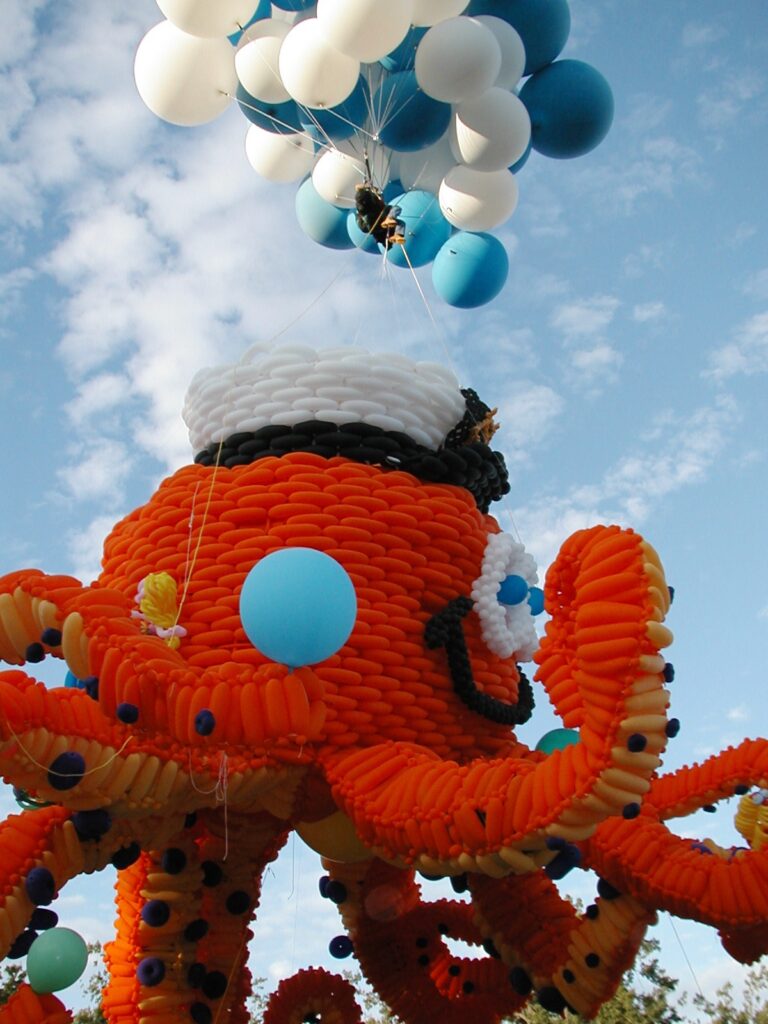
The Barn Where It All Took Shape
Sodus point, NY is a small village on Sodus Bay, off of Lake Ontario, about 45 minutes from Rochester. That was close enough for me to drive back and forth daily, but I still had to find housing for the crew coming from various places around North America. In a village that’s home to only 800 or so people, there weren’t a lot of housing options, for the team or the octopus. For the team, I found a small house that everyone agreed to cram into. Thinking back, I can’t believe just how small a budget we agreed to work with. This sort of project was still very new to us. Everyone wanted to do this because it was a chance to get together and play, not because we could vacation on a beach in luxury. Back in those days, it was pretty normal for us to get together to try something just because someone was covering the cost of materials.
As for the octopus? Its accommodations were even worse. We needed a large open space. We didn’t complain about anything that met our requirements within our very limited budget. The build site given to us was a cavernous boathouse with dirt and gravel floors, and no lighting. The doors weren’t quite large enough to accommodate a 25-foot-tall balloon sculpture, but we figured we’d build in sections and carry it out. We brought in portable work lights. A carpet store offered us discarded carpet remnants to protect the balloons from the gravel. That carpet was probably the best upgrade we made all week. Not only were the balloons safer on carpet, but we could walk around barefoot, the way we prefer on these big jobs. By leaving shoes at the edge of the carpeted area, we tracked less dirt near the balloons.
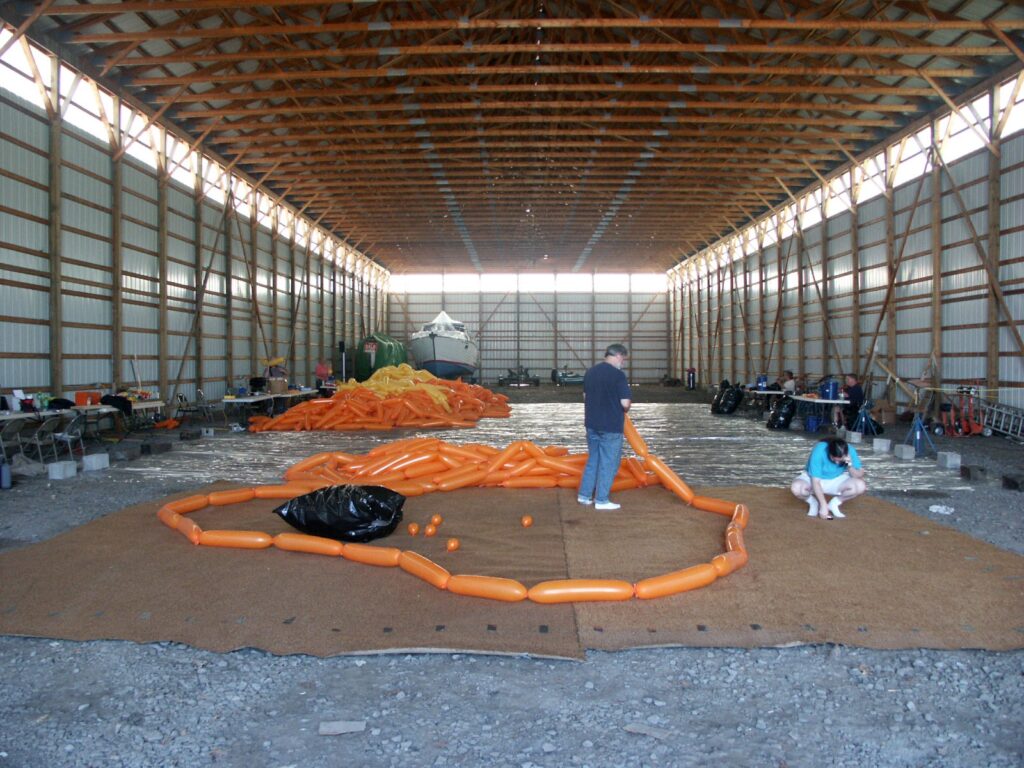
The team included 23 incredibly talented and questionably sane balloon artists from around the U.S. and Canada. Once again, Royal Sorell was drafted to help lead the actual construction. We worked well together in Belgium, so we knew using the same techniques and directing style, we’d be able to make this work as well. And again, Todd Neufeld was there to help identify and manage problems that Royal and I overlooked. We had five days to complete a sculpture that ultimately used over 18,000 balloons. We had plans, but at this early stage of Airigami’s large-scale balloon installations, there was still a lot of learning to do. The projects up until this point taught us about working together as a team. We had a pretty good idea on timing for the number of balloons and people we had. We learned that whenever possible, we didn’t want any framing materials. And we learned quite a bit about how strong sculptures could be with only balloons holding them together. I mentioned earlier that framing would be less safe. Going unframed also meant that if balloons popped while up in the air, the only thing that would be exposed is more balloons. From the ground, no one was going to see a broken balloon or a tiny hole. The rest of the structure, because of the way the balloons were woven together, would support itself. And lastly, since this was going to require a lot of helium, weight was extremely important. We didn’t just need to know that we had enough helium. We wanted John to pilot this safely. In my planning, I accounted for the weight of every balloon, and the lift of the helium. I factored in John’s weight, the weight of his sandbags, his harness, everything on him. All of that time calculating things was going to guarantee a safe and predictable flight.
But it didn’t work quite as planned. I’ll get back to that.
We constructed the octopus in pieces. Arms first—eight of them, each 45 feet long, built from 6-inch diameter airship balloons and new weaving techniques Royal Sorell and I had been experimenting with. The head came next: a massive dome of stacked rows, much like brick walls. We added eyes, a mouth, and eventually a captain’s hat. That was all in the plan.
Every part of the process was a puzzle. The balloons needed to look good but also stay together in the wind. The sculpture had to be strong but light enough to fly. Inside the octopus, we packed helium-filled balloons to reduce its weight. I gave precise measurements to the crew to inflate the large balloons. But they didn’t measure as they inflated. They just stopped when they thought a balloon was big enough. Let’s look at the math. A round balloon with a 36-inch diameter will hold 113 cubic feet of helium. If that same balloon is only inflated to 30 inches, it will only hold 65 cubic feet of helium. That’s a little more than half of what the 36-inch balloon will hold. That means it will lift roughly half the weight. This is not the time to visually estimate if a balloon is inflated enough. But this was the first project my team had done that required lift calculations and safety. My crew always built things that looked cool. Most of them never stopped to consider the math. And since I gave them precise instructions, it never occurred to me that they wouldn’t follow them.
Meanwhile, details on the sculpture kept multiplying. Mermaids. Starfish. Telescopes. A ship’s wheel. Someone made a tiny balloon version of me, gray-streaked ponytail, cell phone, the whole thing, and secretly attached “me” to an octopus arm as if I were fishing from the octopus. I had no idea until it was about to take off. And this is where my calculations went out the window. Everyone just thought it would be fun to add new things. They added design elements to make the sculpture more fun. But none of these extra pieces were in my weight calculations. This on top of the underinflated giant balloons filling the octopus’s cavity and, well, let’s just say my expected weight was pretty far off from the reality of what we built.
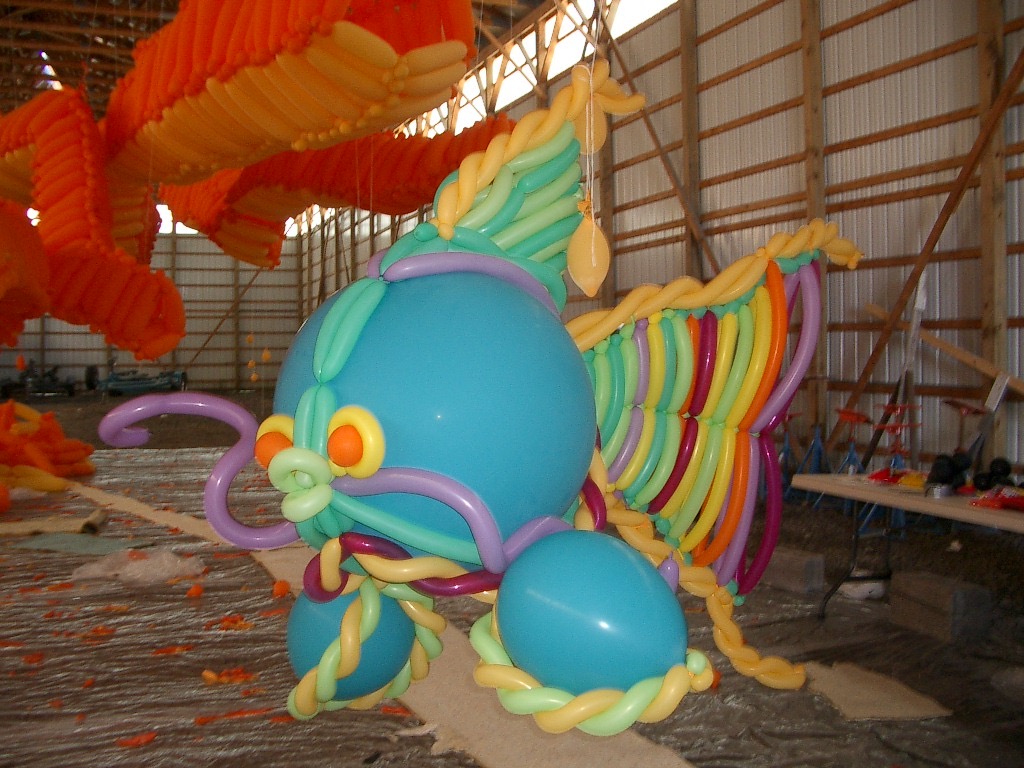
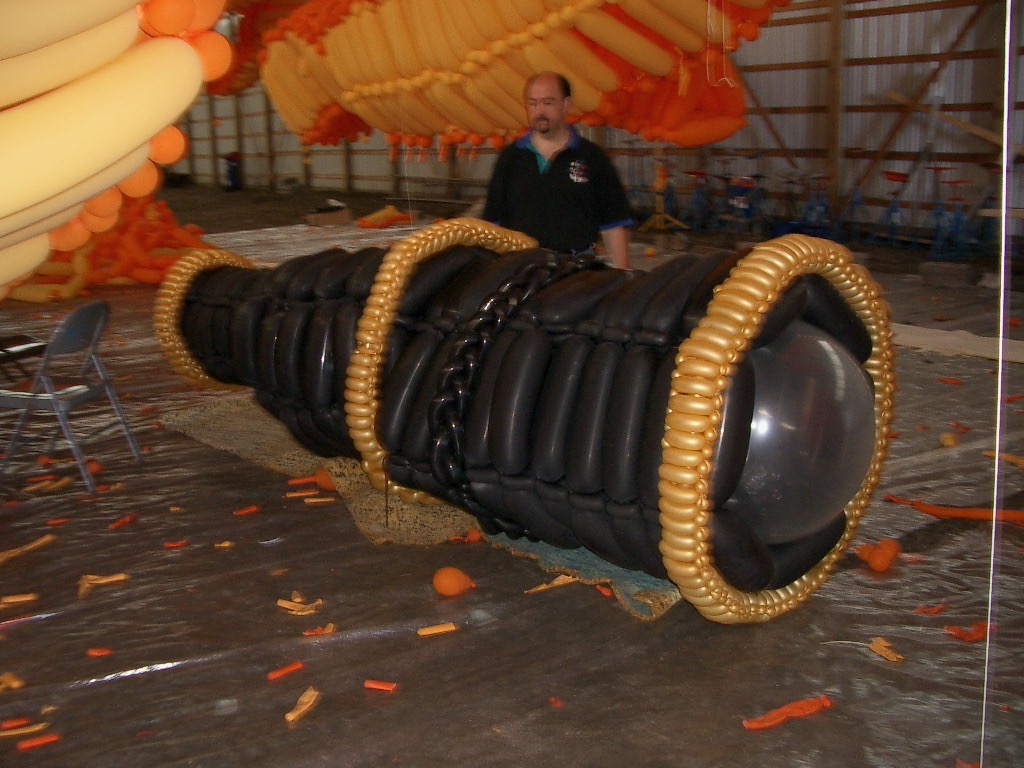
Royal Sorell with his giant telescope.
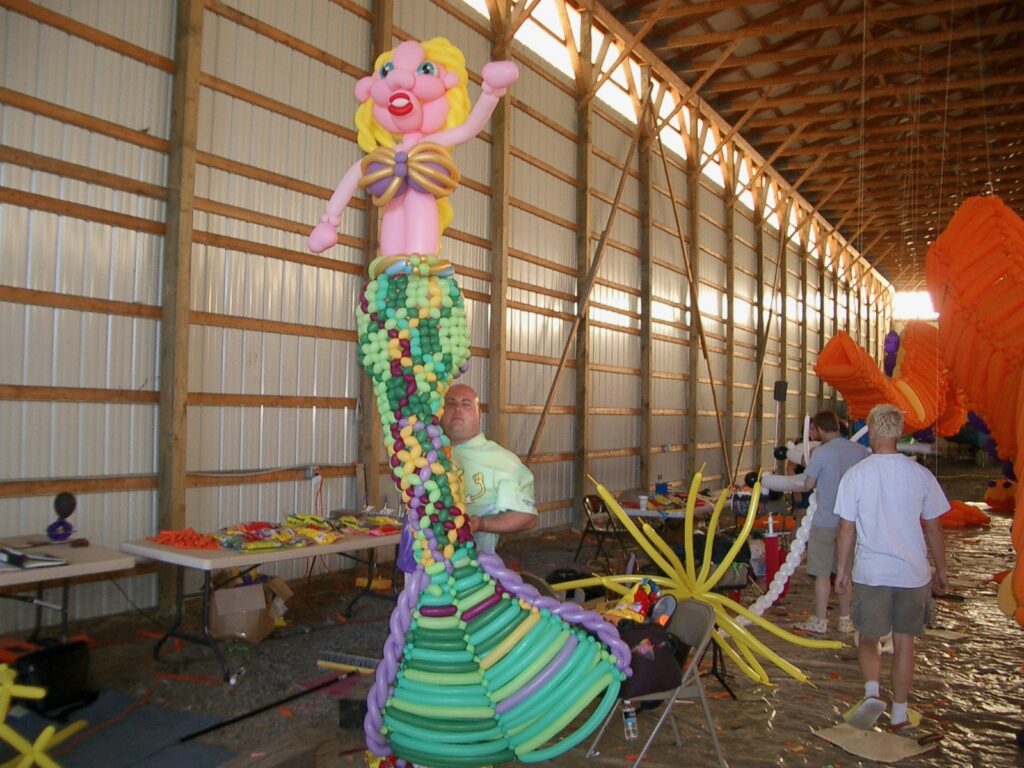
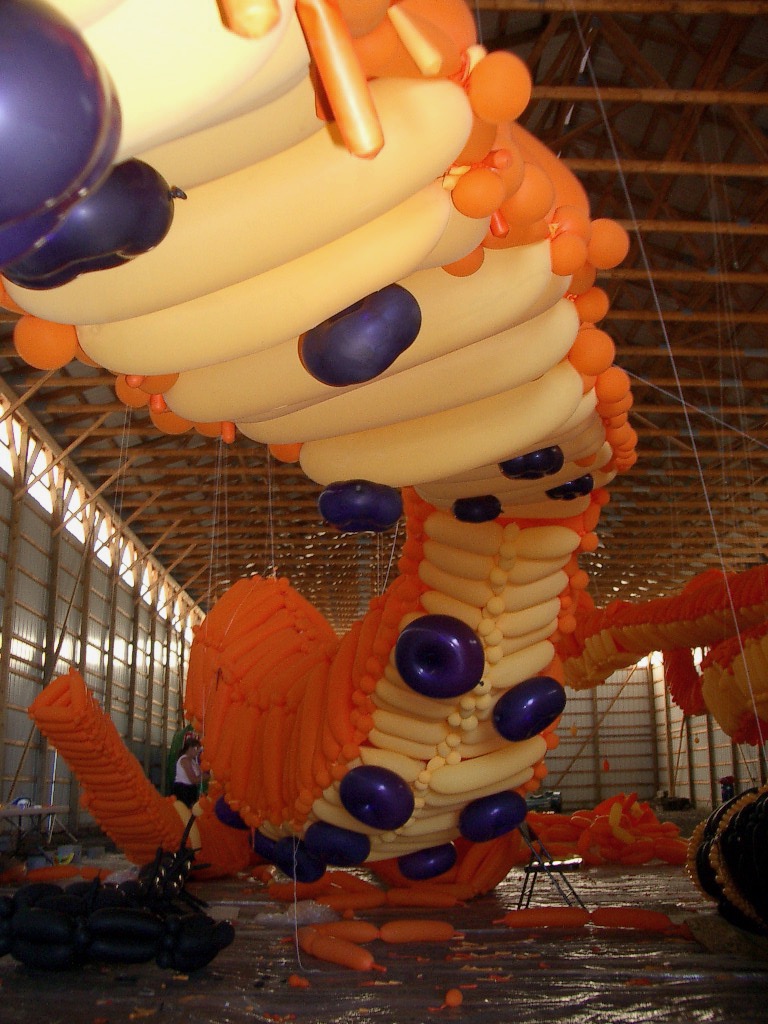
One octopus arm stretching deep into the barn.
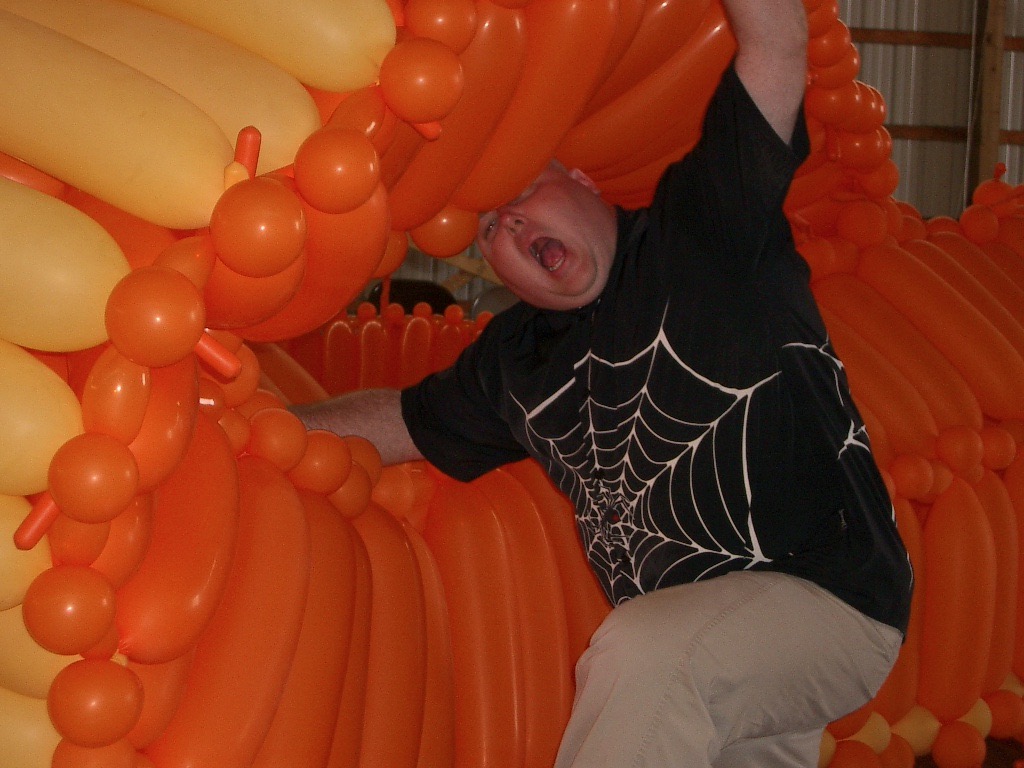
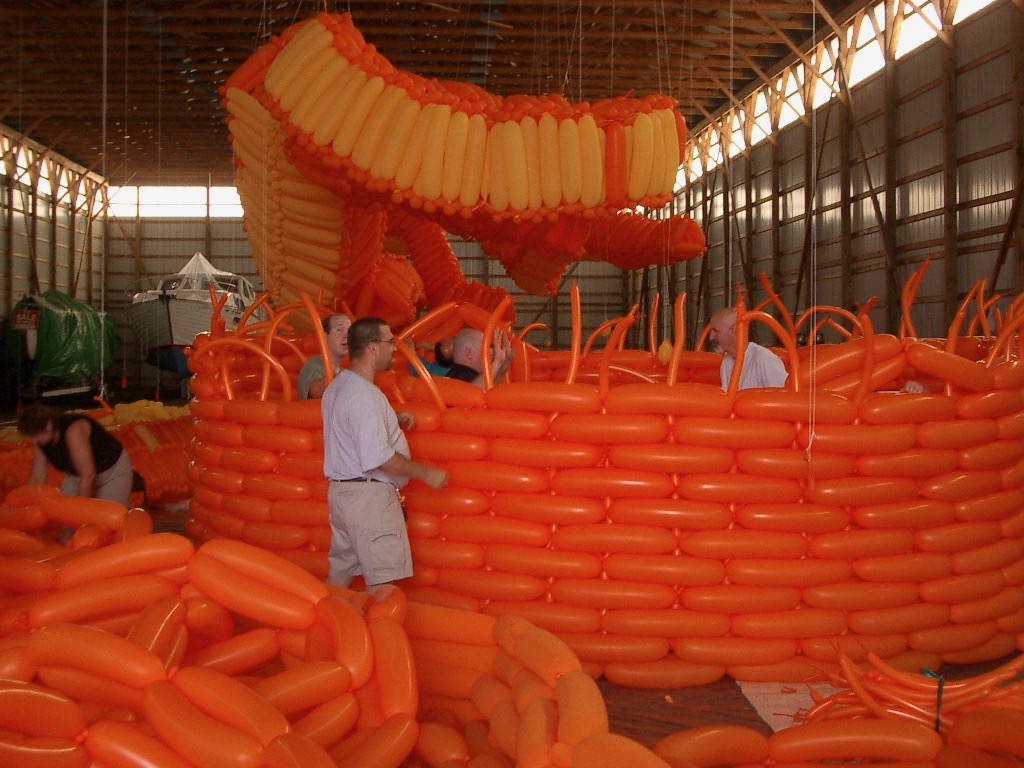

An Octopus Parade
On launch day, we paraded the sculpture through town, tentacle by tentacle, avoiding power lines and chatting with all the people that came to see us. It was an amazing community project. Hundreds of people walked with us, many holding on to some piece of the octopus in order to be part of the entire work of art. An estimated 5,000 people (more than six times the population of Sodus Point) gathered around the ball field to watch us assemble all the pieces and the launch of the flying octopus.
Somewhere in the middle of all of this, I got a call from the sheriff’s office. I had carefully informed everyone that I thought needed to know what we were doing weeks and months in advance. I had been in constant communication with the Coast Guard and the fire department. I had been talking to town officials. I notified the sheriff’s office of what I was doing. They seemed less interested. I kept giving them more info. I asked about traffic concerns for people coming to see this. They didn’t seem to believe that the tiny town of Sodus Point, NY could get that many people. But somewhere in the middle of the craziness to finish the sculpture assembly as the crowd grew, I got a call from the sheriff informing me that Route 104 going to Sodus Point was standing still because of my project and that something had to be done. I was pretty sure at this point that the only thing to be done was to launch and get through this so people would be okay with leaving. So much for me trying to work out a plan for this ahead of time.
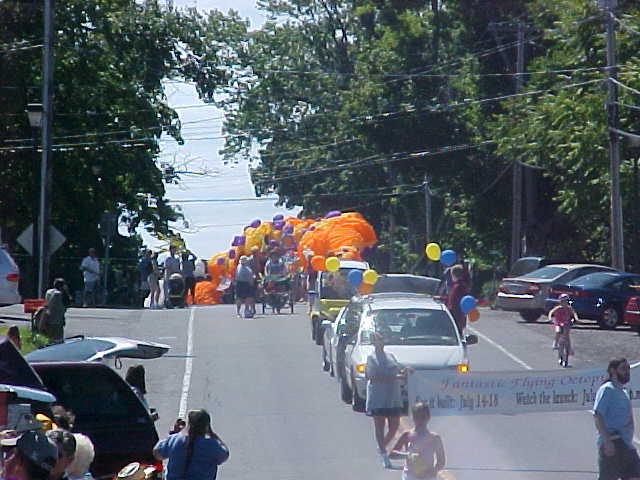
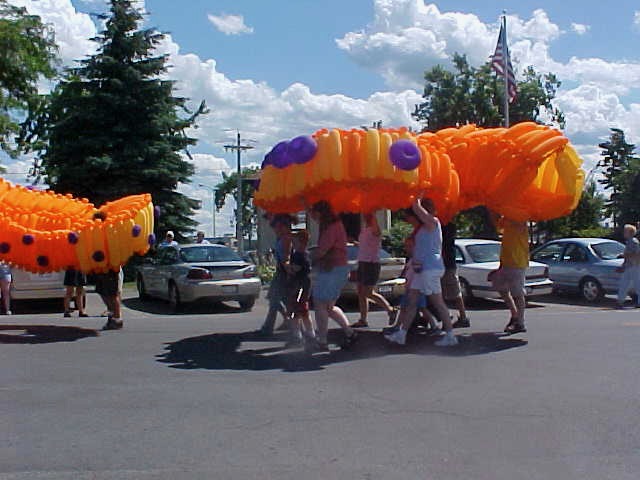
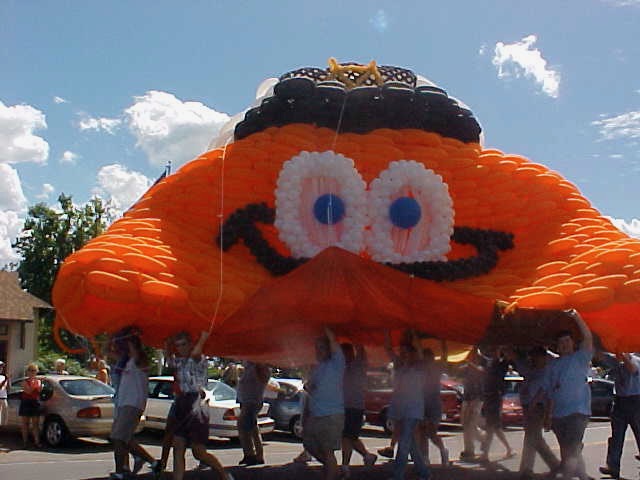
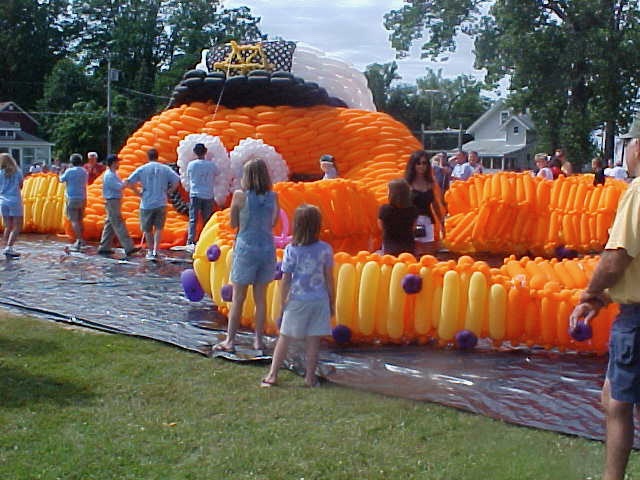
John strapped himself into his harness, suspended beneath nearly 10,000 cubic feet of helium. It was only now that I learned of the weight issues. We added more balloons inside the octopus to lift the 170-pound sculpture, plus John, plus his ballast. We scrambled to take some things off, to add more helium balloons, until it was finally able to lift off.
There was no countdown. No dramatic music. Just a moment where everything got quiet and… it worked. The octopus lifted into the sky. John flew. The crowd cheered. But what I only learned later was that even with last minute modifications, we still hadn’t managed to get the weight of the octopus right. Back during the design stage, John and I agreed that the octopus needed to be neutrally buoyant. In other words, the lift from the helium to the weight of the octopus would be perfectly balanced so that John would barely notice the octopus was there. It wouldn’t force him upward. It wouldn’t drag him down. It was enough of a new challenge for him to have this massive thing attached to him that would react to the slightest wind. We wanted to remove as many variables as we could and expected that John would only need to manage the balloons over his head to control his flight.
John wanted to fly as much as we wanted him to fly. So, as we were adding helium and removing weight, he was dropping some of his ballast. I wasn’t aware of that. I just watched him slowly take off to rousing cheers.

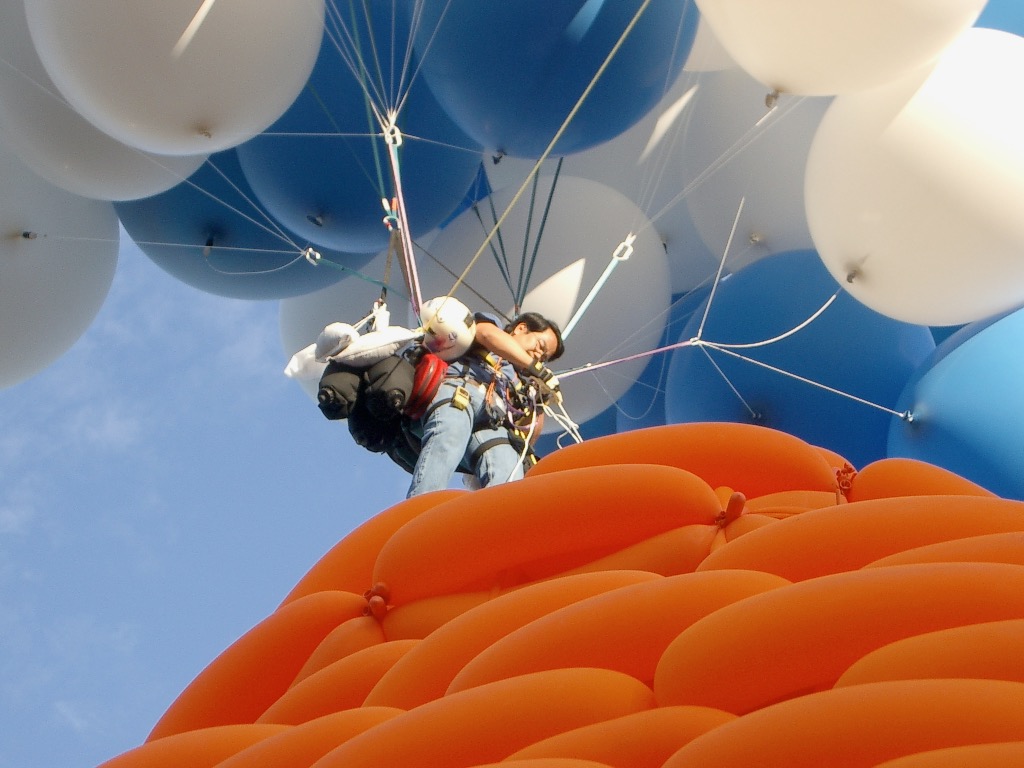
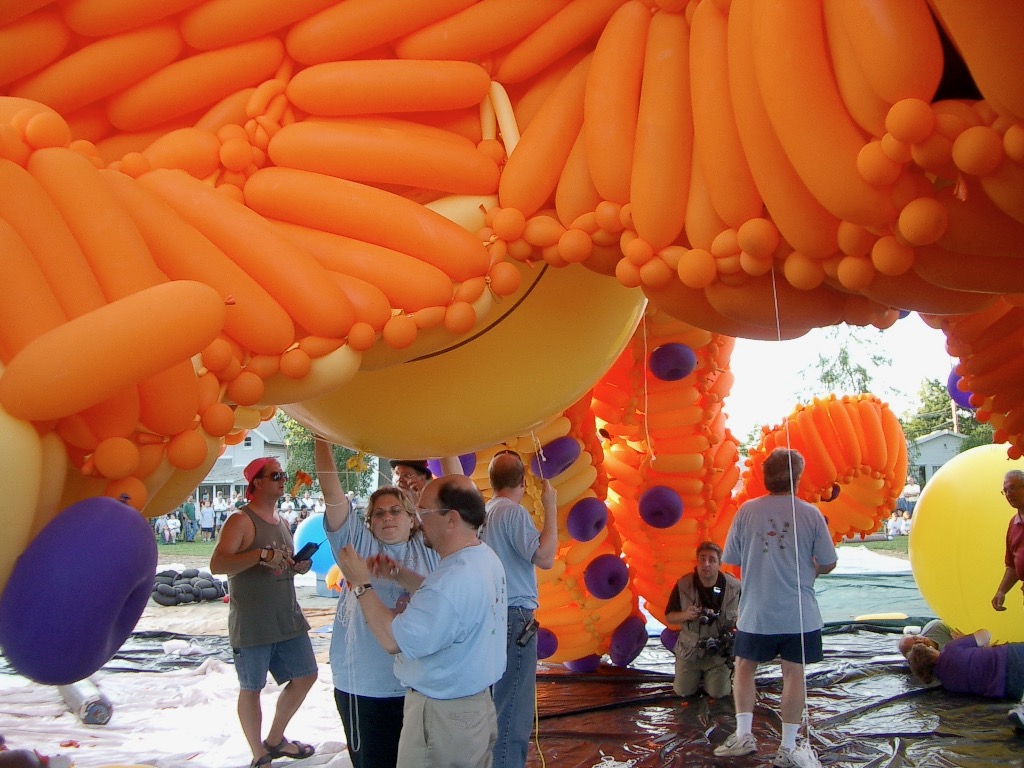
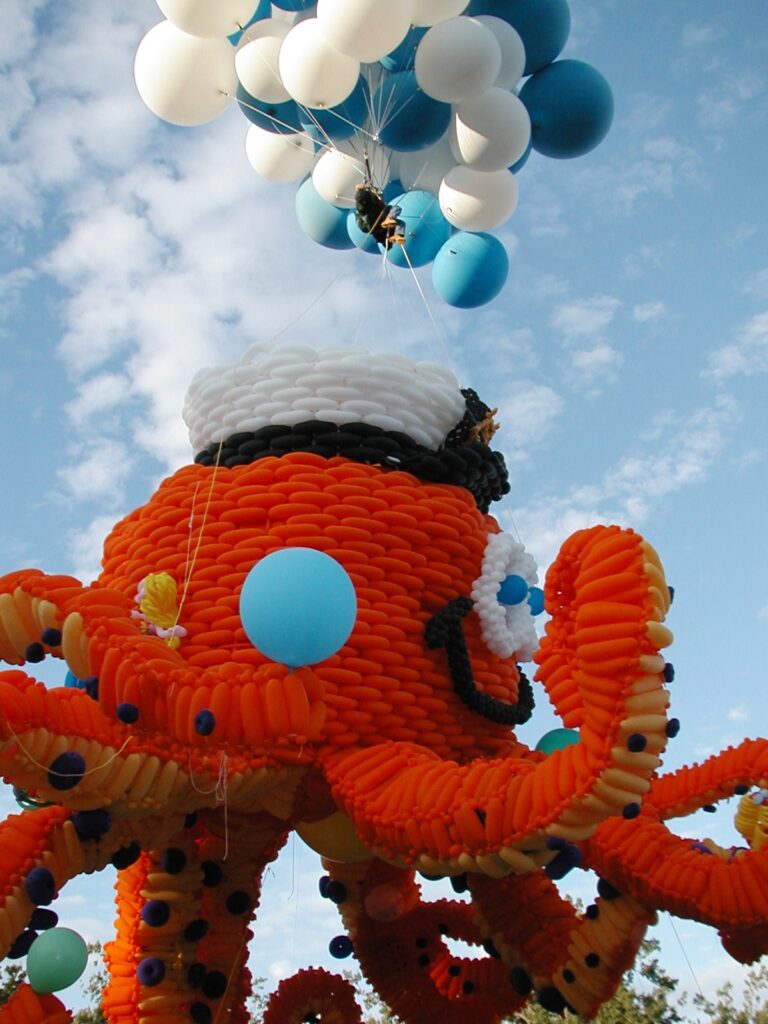
The Flight
It was time for me to run, literally. A project like this wasn’t going to happen without me getting good footage. And since I always wanted to fly, I was going to use this as my excuse to get into the air myself, with a camera. Once I saw John was in the air, I took a few pictures of it lifting off, and ran about a half mile down the road to where another pilot was waiting for me with a much better tested vehicle than our flying octopus. He had an ultralight aircraft, specifically a powered parachute, waiting for me. I jumped aboard and he took off. Tim Bayer, the videographer that had been recording the entire build (and even jumped in a few times to be part of the project), was already in the air, in another powered parachute. He was recording John’s flight from the air right from the start. I was just following to get stills.

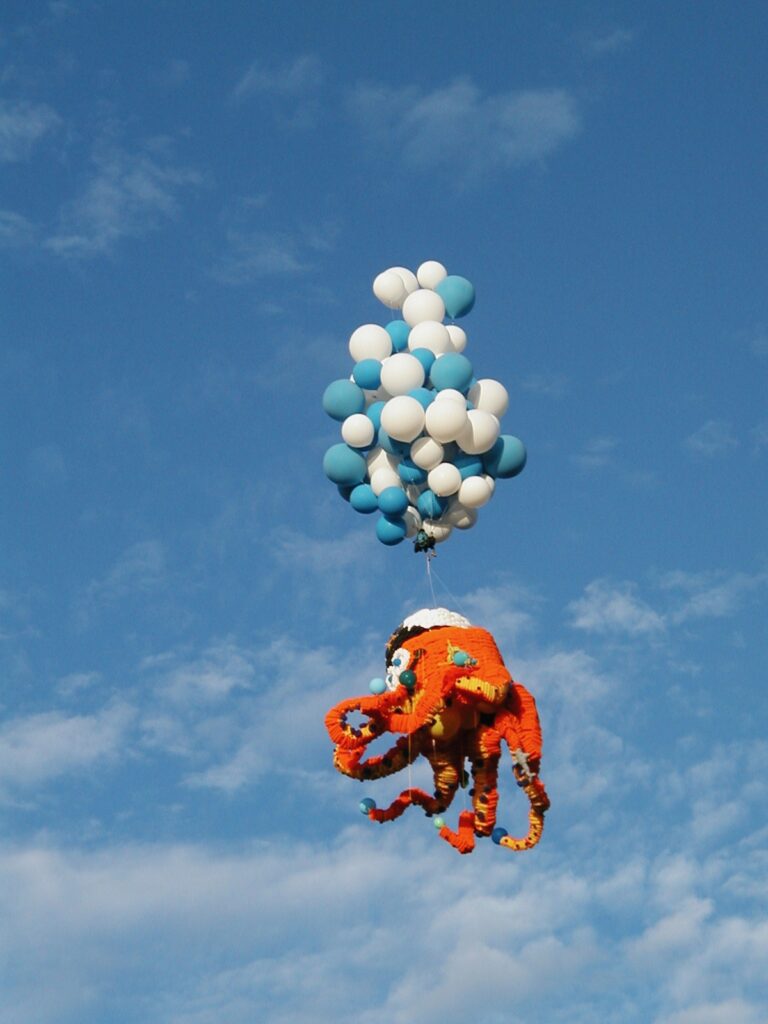
John had hoped his flight would last about an hour. It wasn’t even close. There was too much wind. The plan was for John to drift over Sodus Bay and land on a boat in the bay. He made the call to end the flight early, before the wind blew him either over land or out too close to the lake. We had a backup plan in case he couldn’t steer right to the boat. There were two more boats below that could get him. One of them was a Coast Guard boat. So in the worst of all situations, the Coast Guard was ready to get him. We also had the fire department on shore watching the whole thing from their amphibious vehicle, ready to jump in no matter where he ended up.
The Landing
In order to perform a safe landing, John unhooked the octopus from himself and let it drift beautifully over the bay. But without John steering it, the octopus was purely at the mercy of wind and gravity. It didn’t land in the water as planned. Instead, it flopped gently onto the roof of a boathouse. The crowd was now watching this beautiful creature floating slowly downward until it seemed to swallow the boathouse like in an old horror movie. Most people’s eyes were on the octopus and the fire department springing into action to pull the beast from the roof of the building. It was only moments later that everyone noticed that, freed of the octopus’s weight, John shot upward. This is where all of that talk of weight ratios and neutral buoyancy really became important. Had the creature been built as planned, with nearly zero weight, John would have just floated in the spot where he let it go, making the remainder of his flight safe and fun.
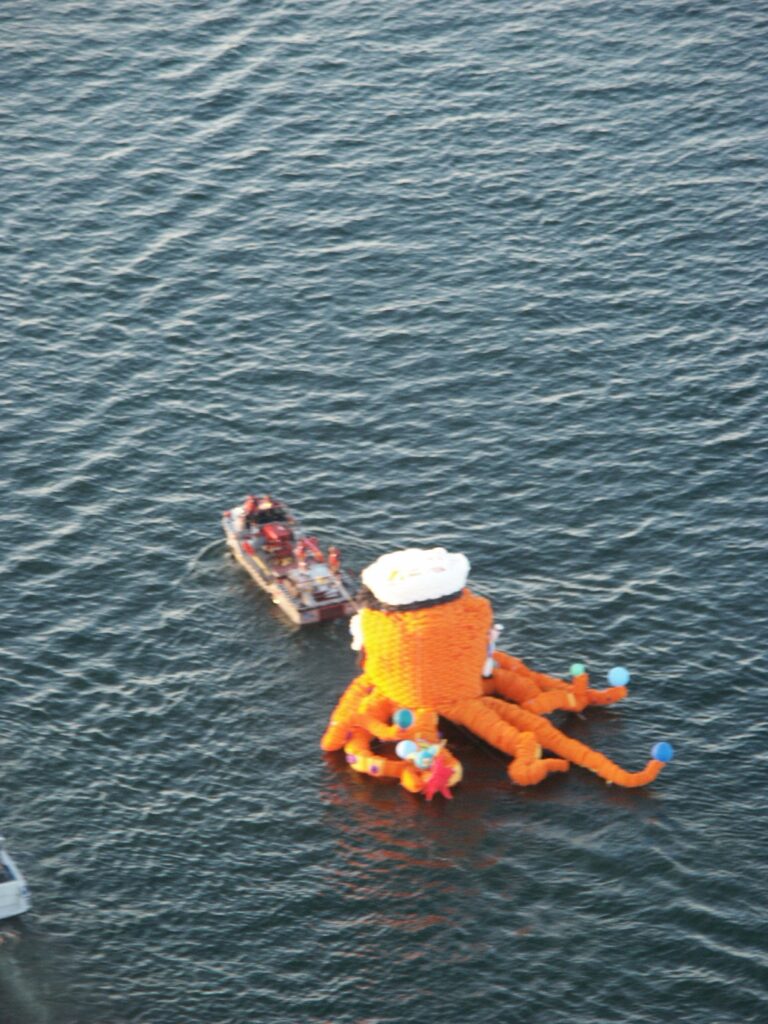
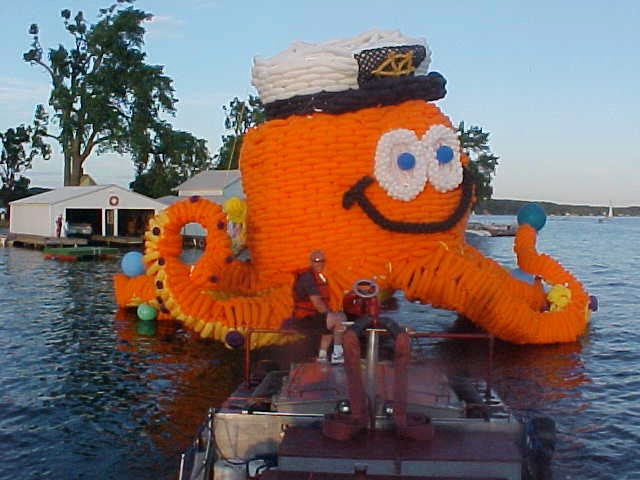
Unfortunately with the weights being wrong, John went into a rapid ascent that required him to act quickly before all control was lost. This is why I had a pilot and not just a stuntman, and where John’s experience as a cluster balloonist really became important. He did what he needed to without losing his cool, popped a few helium balloons above him and controlled his descent until he landed safely on the recovery boat exactly as intended.
With John now safe, it was time to clean up. Even the cleanup was planned. The fire department towed the octopus to shore. We announced that there were prizes (actually coupons for prizes) inside some of the balloons. Anyone from the public that wanted an opportunity to find a prize, just had to help pop the octopus and pick up all of the broken balloons. The crowd tore it to pieces.
Six hundred hours of build time. Five minutes to destroy. Memories saved for a lifetime.
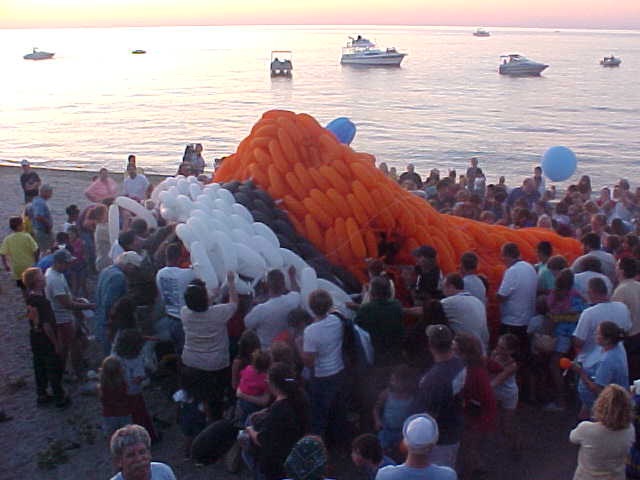
See the entire process of building the sculpture in the Flying an Octopus documentary by Tim Bayer.
Safety First
The idea of flying with a bunch of helium balloons isn’t new. Who hasn’t imagined grabbing a fistful of party balloons and floating off into the sky? The difference is, most people don’t actually do it. Some do.
Probably the most infamous attempt was by Larry Walters—aka “Lawnchair Larry”—who in 1982 strapped 42 helium-filled weather balloons to a lawn chair and promptly ascended into commercial airspace over Los Angeles. It was bold. It was ridiculous. It was not safe.
While our project wasn’t perfect, we did actually plan for safety. We tried to account for every possible thing that could go wrong. We coordinated with local authorities, including the Coast Guard, fire department, and other safety organizations.
John, our pilot, wore an emergency parachute. Thankfully, he didn’t have to use it. But that raises a natural question: would it have worked?
John only ascended to about 1,000 feet. With the wind conditions, he didn’t feel safe going higher. That altitude falls into a bit of a gray zone when it comes to parachute effectiveness.
Here’s how parachute altitudes typically break down:
• Minimum safe altitude: ~600 feet
This is the bare minimum for deploying a small reserve chute. It might save you, but you won’t have much control.
• Recommended for safety and steering: ~2,000–2,500 feet
This is ideal for sport parachutes—plenty of time for deployment, stabilization, and maneuvering.
• BASE jumping parachutes: ~200–300 feet
These are built for rapid deployment at low altitudes, but they require specialized gear and training.
So where does that leave John at 1,000 feet?
It’s just enough. He was well above the bare minimum for an emergency chute and within the range where a BASE-style canopy could function reliably. Most cluster balloon pilots—like John—carry:
• A BASE-style parachute (for fast deployment), or
• A paragliding-style harness with a reserve chute, suited for gradual ascents like his.
In short: 1,000 feet is probably enough. But it’s not generous. It gives you a shot at survival—just not a margin for error.
Credits
Pilot: John Ninomiya
Project Manager/Designer: Larry Moss
Flight/recovery
Lead: John Ninomiya
Crew: Ernie Hartt, Jenny Wolf, Nancy Samuels, Alan Samuels, Alice Irwin, Ethan Irwin, Bob McIlroy
Sculpture construction
Lead: Larry Moss, Royal Sorell
Crew: Todd Neufeld, Patty Sorell, Debbie Piotrowski, Connie Iden-Monds, Buster Balloon Caldwell, Mary Ann Jakubowitz, Norma Jean DiRoma, Nita Landes, Richard Hughson, Roger Ragan, John Barthelmes, Sandi Masori, Dick Kleitz, Steve Brown, Mark Verge, Michael Necheles, Ian Stewart, Bob Williams, Lee Brusa, Maggie Brusa, Sarah Adams
Tech crew
Richard Hughson, Tim Bayer
Photo/video
Tim Bayer, Larry Moss, Todd Neufeld, Mike Necheles, Jeff Collins
Community volunteers
This project never could have been completed without the help of many community volunteers. Thank you to everyone that took part.
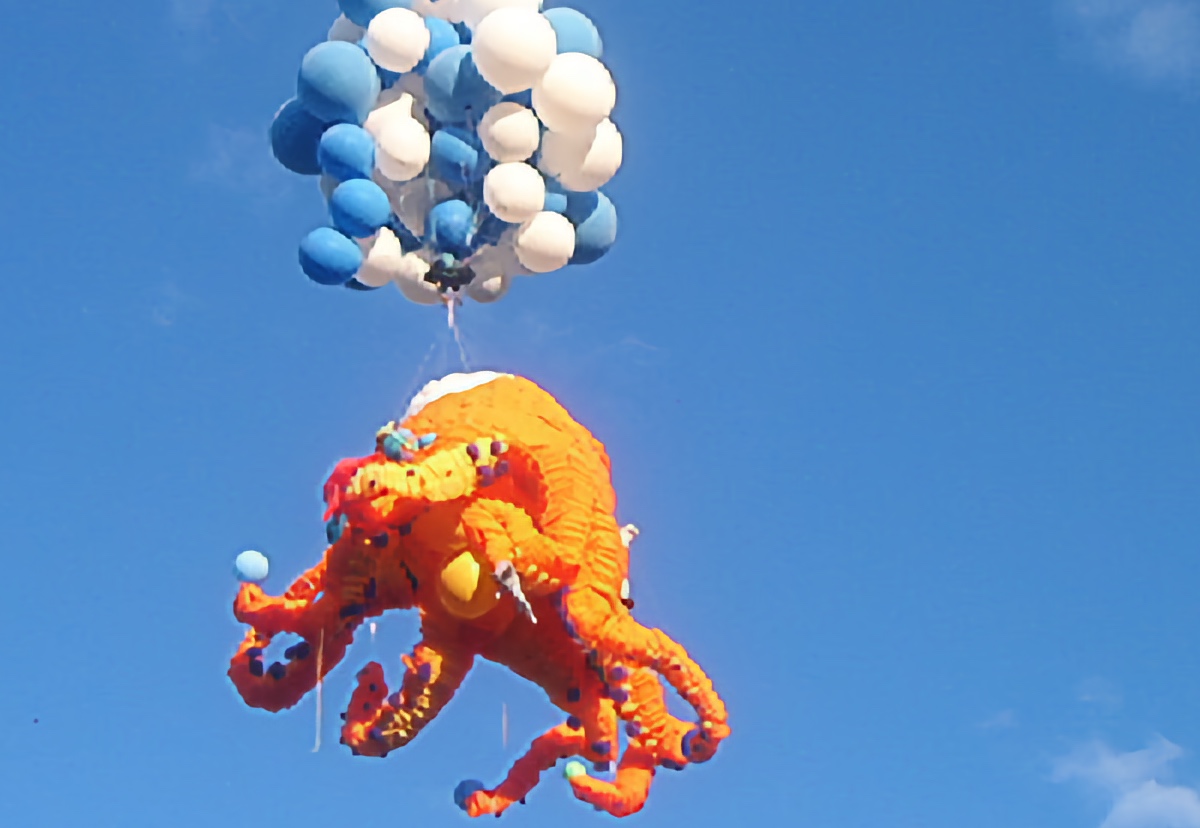
1 thought on “Flying An Octopus”